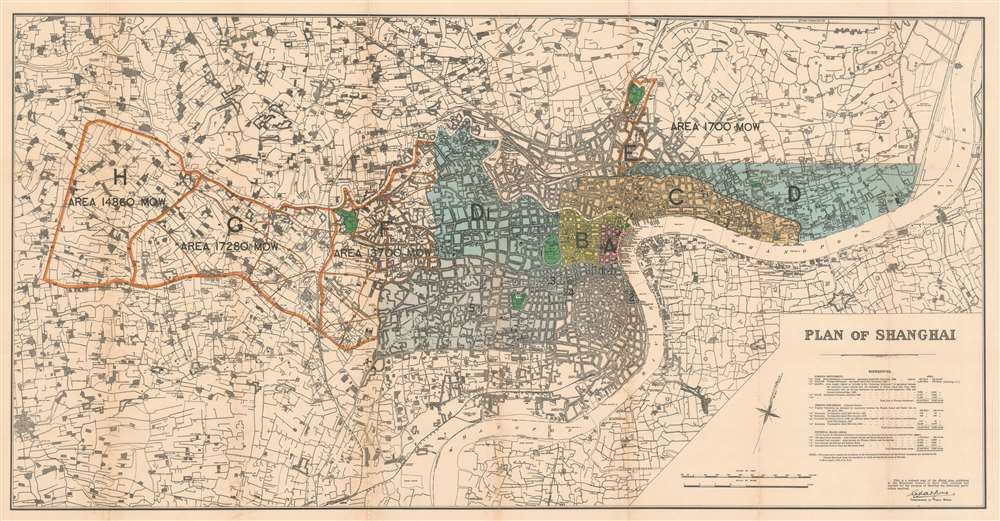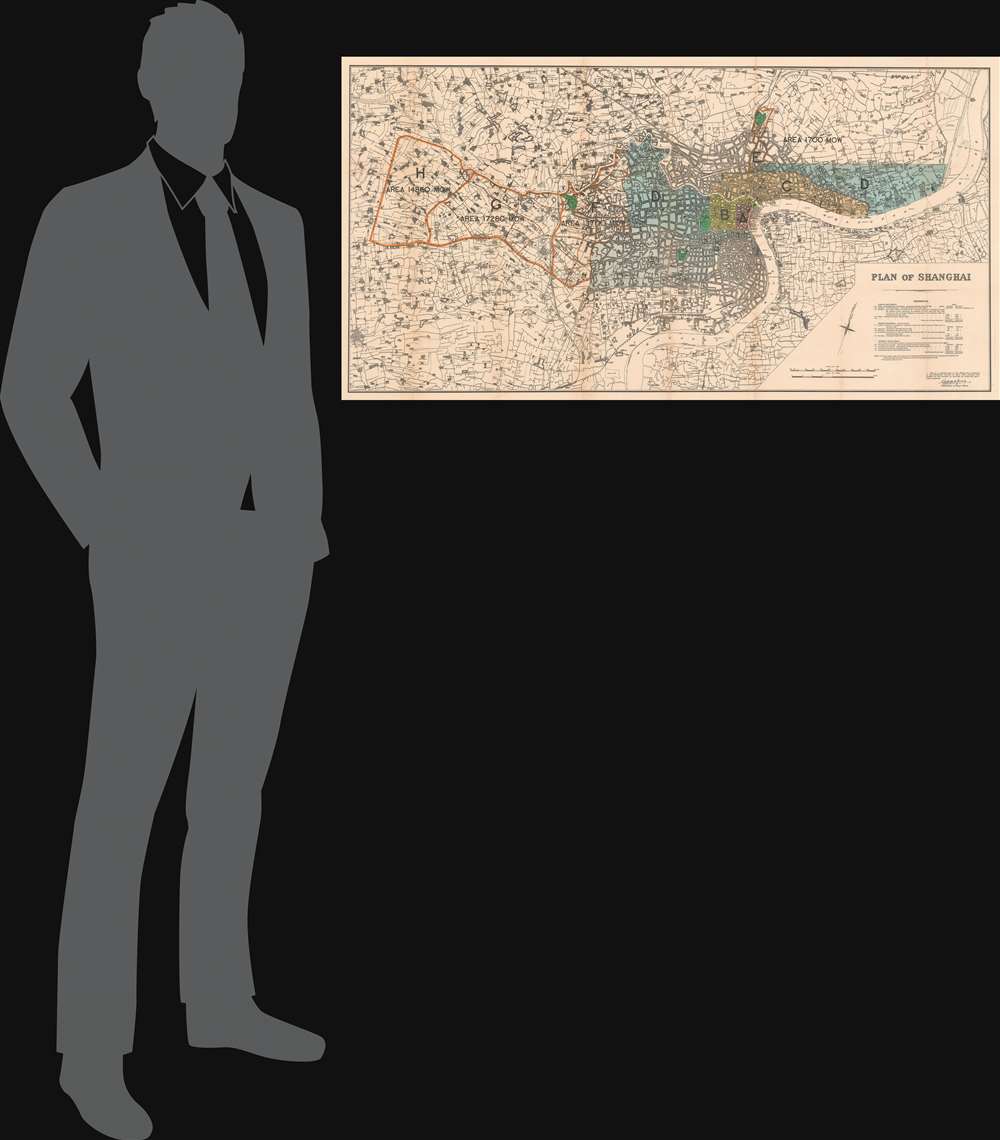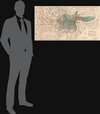1928 Kelly and Walsh Map of Shanghai w/ development of Concessions
Shanghai-kellywalsh-1928
Title
1928 (dated) 20.5 x 40.5 in (52.07 x 102.87 cm) 1 : 25000
Description
A Closer Look
The map has been fascinatingly color-coded to trace the development of the foreign concessions from the creation of the British Concession in 1846 to the radical expansion of the French Concession in 1914, with additional updates to 1928. The map also includes external roads - these are roads beyond the formal concession boundaries that were built, maintained, and administered, and thus controlled, by the concession governments, thereby extending extraterritoriality. These extensive regions feature overprinting defining their size in mau (mow), each of which is roughly 1/6th of an acre. The map is signed (in print) in the lower right by Charles H. Godfrey, the Municipal Council's Commissioner of Public Works.Shanghai 1910 - 1932
The 1910s-1920s were a golden age for Shanghai. While China was ruled by Chiang Kai-shek, Shanghai was dominated by several consolidated foreign trade Concessions. Under the strict administrative control of the Concessions, the city became a cosmopolitan haven amidst political unrest and a center for global trade and finance. The Concessions occupied what is today central Shanghai's most desirable land, hugging the Huangpu River and the Wusong River (also known as Suzhou Creek). These extraterritorial European, Japanese, and American enclaves had elegant housing, fine roads, streetcars, elegant shops, clubs, and more. It was a place of excess, art, and extravagance, where fortunes could be made by the enterprising - and lost by the foolish. Moreover, lacking the moral constraints that limited social life in Europe and America, Shanghai became a nexus for the opium trade, sexual excess, gambling, and other vices. This ephemeral world came crashing down on January 28, 1932, when the Shanghai Incident, also known as the January 28 Incident, pitted the Republic of China against the Empire of Japan. Responding to Chinese student protests against the Japanese occupation of Manchuria, the Japanese Navy bombarded Shanghai. Chiang Kai-shek sent the Chinese army in to defend the Shanghai students, threatening to escalate the conflict. The League of Nations, fearing all-out war, united to demand a ceasefire, which was signed. Nonetheless, most consider The January 28 incident to be the opening salvo of the Second Sino-Japanese War (1938 - 1945), which ultimately merged into World War II.Shanghai International Settlement
The Shanghai International Settlement was created in 1863 when the British and American Shanghai enclaves merged. These concessions had been granted to England and the United States as part of the Unequal Treaties that followed the Opium Wars. From about 1854, the settlements were governed by the Shanghai Municipal Council, a British-dominated board of government officials and powerful merchants. The board issued restrictions limiting Chinese habitation on International Settlement territory and oversaw the construction of public services, including trams, a sewage system, highways, and port buildings. The International Settlement expanded several times in the late 19th and early 20th century. It became an enclave of peace and prosperity when the Japanese invaded Shanghai in 1937, but this abruptly came to an end with the Japanese bombing of Pearl Harbor and the subsequent invasion of the International Settlement in 1941. After the war, the International Settlement lands were returned to Chinese sovereignty.Shanghai French Concession - 上海法租界
On April 6, 1849, Lin Kouei (麟桂), the Chinese governor of Shanghai, granted French Consul Charles de Montigny (1805 - 1868) a proclamation ceding extraterritoriality to France to establish a trading colony. The Concession initially occupied a narrow collar of land around the northern end of the Chinese City, south of the British settlement, an area of 66 hectares. It was subsequently expanded several times. A further small strip of riverside land to the east of the Chinese City was added in 1861 to allow for the Quai de France, docks servicing shipping between China and France. Between 1899 and 1900, the French Concession further expanded, nearly doubling in size with new territory extending west of the original grant. It expanded again in 1914, reaching as far west as modern Huashan Lu (Avenue Haig) - as seen here just 3 years after the expansion. By the 1920s, the western part of the French Concession had become the most desirable residential area in Shanghai, popular with both foreign nationals and wealthy Chinese. The Concession was mistakenly bombed during the chaotic 1937 Battle of Shanghai, fought between the National Revolutionary Army (NRA) of the Republic of China (ROC) and the Imperial Japanese Army (IJA). In 1943, the French Concession was handed over to the Japanese puppet Wang Jingwei Regime by Vichy France. The turnover was officially ratified after the war by the Sino-French Accord of February 1946, signed by the French Ambassador and Chiang Kai-shek. Today, the French Concession, with its tree-lined boulevards and French colonial architecture, remains Shanghai's most desirable neighborhood.Publication History and Census
This map was published by the Shanghai printing firm of Kelly and Walsh under the authority of the Shanghai Municipal Council. This map is scarce. We have identified only one other example, which is located in the collections of the National Library of Australia.CartographerS
Kelly and Walsh (1876 - present) was a Shanghai based and managed publishing concern founded in 1876. The firm was organized around the consolidation of the Yokohama and Shanghai based Kelly and Company, owned by the Irish printer John M. Kelly, and the Scottish booksellers F. and C. Walsh. The firm was formally incorporated in Hong Kong on July 1 of 1885, when it sold some 1350 shares, most to Thomas Brown, a Shanghai resident to acquired 1114 of the outstanding shares. The remainder were acquired by a variety of stationers ad printers a 11 Bund, Shanghai, presumably Kelly and Walsh employees as this was their operating address (later they relocated to 66 Nanking Road in 1918, with offices also at 12 Nanking Road). The firm was most active from the 1870s to the 1940s, when it expanded into a variety of related business: bookseller, stationer, publisher, printer, lithographer, book binder, die engraver, color stamper, India rubber stamp manufacturer, news agent, music seller, commission agent, and tobacconist. There is some evidence that Kelly was active in Providence, Rhode Island, acquiring partial interest in the firm of Bubee and Hall, but it is unclear if in divested of his Asian interests. By the outbreak of World War II they had offices in Hong Kong, Yokohama, Tokyo, Singapore and Hankou (Wuhan). When the Japanese occupied Shanghai, the firm moved its management offices to Hong Kong, where it was acquired by Swindon Book Company in the 1950s. The Singapore branch of Kelly and Walsh, established in the prestigious Raffles Palce, operated an English language bookshop through from about 1881 to about 1956, publishing more than 200 titles and having its own bindery. The firm still operates a small chain of swank bookstores in Hong Kong. More by this mapmaker...
Shanghai Municipal Council (July 11, 1854 - 1943) was an organization of businessmen leaders in Shanghai active from middle part of the 19th century to the early 20th century. The organization was formed on July 11, 1854 by a group of influential western businessmen who argued that Shanghai suffered under a lack of proper municipal governance. It laid down land regulations and began to assist in the construction of new roads, established refuse collection, and even initiated taxation. By the late-1860s Shanghai's official governing body had been practically transferred from the individual concessions to the Shanghai Municipal Council (工部局). The British Consul was the de jure authority in the Settlement, but he had no actual power unless the ratepayers (who voted for the council) agreed. Instead, he and the other consulates deferred to the Council, which was made of 9 figures, 5 from the British Settlement, 2 form the American Settlement, and 2 from the Japanese Settlement. No Chinese were permitted to serve on the council until 1928. By the 1880s the council acquired a virtual monopoly over city utilities, controlling gas-suppliers, electricity producers and water-companies. Later, in the early 20th century, they also took control of rickshaws, tramways, and regulated opium sales and prostitution. The council maintained its own police force, fire service, and military reserve, the Shanghai Volunteer Corps (萬國商團). The Municipal Council was disbanded in 1943, in World War II, when the Japanese closed all foreign concessions (except the French). Learn More...




